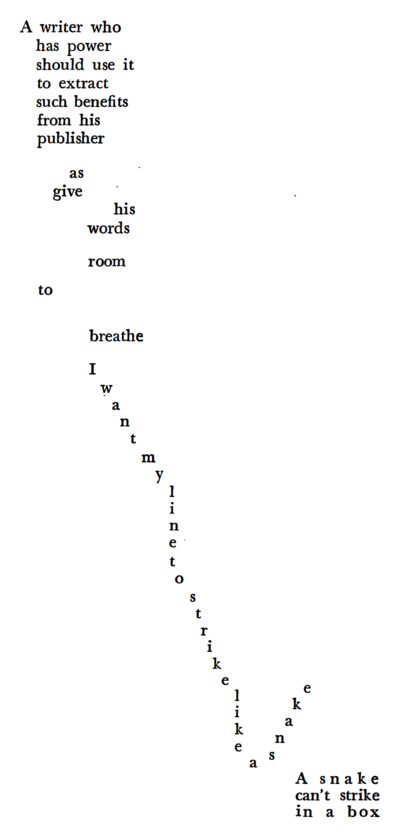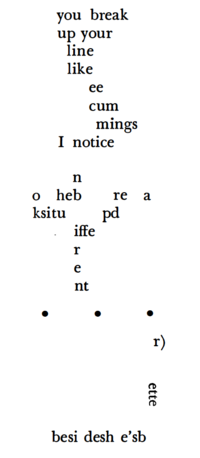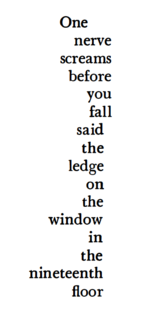The Structured Vision of Norman Mailer/6. Deaths for the Ladies and Other Disasters
When Mailer is good he can be very good, and when he is bad there is no one worse. But it must be said that the most dismal failures of his art proceed from the same persistent motivation: the desire to go beyond what he has already achieved, into unexplored regions of his talent. Thus, in his refusal to remain static, he may desert a successful formula only to fail, as in Barbary Shore or Why Are We in Vietnam?; or he may succeed in his experiment, as in An American Dream.
Similarly, Mailer has made periodic excursions into other genres, and here, too, his failures glare garishly enough to obscure his successes. Within the province of fiction, he has accomplished little with the short story, that traditional laboratory and financial supplement of the novelist.[1] In the drama, on the other hand, he has been relatively successful. The play version of The Deer Park (which I saw on March 3, 1967) is not great literature, but it is substantial, entertaining theater; and it earned a reasonably sympathetic critical reception. Lately, Mailer has turned his hand to making movies. His first film, Wild 90, is embarrassingly bad. It is a tedious story of three criminals in a hideout, which I found difficult to sit through. The second movie, Beyond the Law, which I have not yet seen, has been better received by some critics, and cannot help but be an improvement over Wild 90. Mailer’s third movie, Maidstone, which has not yet been released at the time of this writing, has already attracted considerable attention because of the bizarre, party-like circumstances under which it was shot.[2] Since each of these movies features Mailer as star, as well as producer and director, his cinematic efforts increase still further the considerable influence which his flamboyant personality exerts upon the public’s conception of him. (The relation between this public image and the critical reception of his books will be discussed in my next chapter.) Whether or not Mailer’s later movies achieve any real artistic stature, they do represent some sense of serious experimentation on his part, one which is underlined by the substantial investment (both in finances and reputation) which he has made in them.
The most painful disappointment to someone interested in Mailer’s work (but who does not wish to assume the role of Mailer apologist) is his poetry. Almost every poem Mailer has ever written appears in a volume entitled Deaths for the Ladies and Other Disasters, although many of these poems and a few new ones are sprinkled through the nonfiction collections, and one or two are worked into The Deer Park (N) and An American Dream.
Deaths for the Ladies is one book which it appears Mailer was more foolhardy than brave to publish, for there is no significant literary merit anywhere in it. The few worthwhile poems which are included are not worthy of an entire volume, and most of the pieces are not worthy of the entire page which each occupies. It is certain that no major American publishing house would have considered the book without the benefit of Mailer’s name to help sell it. Nonetheless, it is unfortunate that the book is pejoratively associated with Mailer’s reputation but not usually associated with his other work; for it is only in the context of the entire body of his writing that the poetry assumes any interest. Just as An American Dream (which may seem at first to some readers a sloppy, self indulgent fantasy) appears clearer in purpose and execution when read in light of what precedes it, Deaths for the Ladies is largely incomprehensible without extensive reading in Mailer’s prose. But unlike An American Dream, it cannot be justified as a significant book even after careful study has unearthed some coherence in the patterns it presents.
For what it is or isn’t worth, the book is conceived as a whole, an intention which is partially implemented by the device of omitting any pagination.[3] Refrains and echoes of early pages reappear later in the book, suggesting that Mailer is attempting to erect and reinforce a structure from his grab-bag of minor perceptions, epigrams, and personal horrors. In order not to overemphasize the very limited extent to which this attempt is successful, I would first like to establish some perspective by quoting a few of the more precious poems. (Mailer calls them “short hairs.”)
A few attempt to explain the nature of the book itself, as:
The art of
the
short hair
is that
it
don’t
go on
for
too long.
And:
This is
genteel
poetry.
One thought
at a time.
But the clearest insight into the form of this poetry and into Mailer‘s own attitude toward its publication comes from this poem:
The poem suggests that Mailer is waggishly aware of the fact that it is the power of his name rather than the merit of his poetry which has persuaded the publisher to allow him carte blanche in presenting this material. This poem is also a good example of Mailer’s derivative use of the devices of other poets. On the next page, he acknowledges the influence of E.E. Cummings evident here:
And on the following page, within his own poem, he italicizes this echo of Wallace Stevens:
the emperor is the
emperor of ice cream
Other literary influences are advertised as well. For example, Mailer uses a quotation from T.S. Eliot as an epigraph to a poem and dedicates two “wanderings in prose” to Hemingway. The latter are highly personal and rather poignant pieces about Mailer’s own life. And in “Farewell to Arms Revisited,” Mailer deals wittily with how Catherine and Frederick Henry would feel had they been married for twelve years.
Some of the individual poems are interesting in themselves, worth a chuckle or a wince:
Cheerleader
She
went to
Southern
Baptist
U
but
somehow
she nev-
er did
find out
who
John
the Bap-
tist was.
• • •
Definition of a Hero:
He
thrives
in
dikes.
• • •
Exodus
goodbye America,
Jesus said.
Come back, boy! [4]
we cried
too late.
• • •
If
Harry Golden
is the gentile’s
Jew
can I be-
come the Golden
Goy?
• • •
Men
who are not
married
and grow beards
are insecure,
said the CIA
before
it went
to Cuba.
The most serious artistic attempt which Mailer seems to be making in this uneven book is to present the entire volume as one continuing experience. The device upon which this attempt at structure and continuity rests is the use of fugue-like repetitions from one part of the book to another. One of these provides a particularly good example of the way in which repetition establishes and reinforces a thematic statement:
doing the limbo bit
doing the limbo bit
it's good enough
for me
This bit of doggerel, taken from a popular song, appears several times, at intervals. Two primary associations occur immediately, and are reinforced by the monotony of repetition. First, the obvious derivation of the poem from a particularly mindless example of popular entertainment implies that our popular culture is tasteless and without meaning. Secondly, the speaker, in “doing the limbo bit,” is saying in popular parlance that he is in a limbo (although the song itself means literally that he is doing the dance called the limbo). Both of these associations are encompassed by the intentional irony of the last line, “it”s good enough for me,” in which the speaker makes it clear that he is quite willing to accept the status quo of a personal limbo within a vacuous society.
Within the structure established by such repetitions, Mailer introduces a number of themes to which he returns throughout the book. One of these is the metaphor of cancer (already dealt with above in terms of the novels), which is viewed in a number of contexts, as:
Cancer Gulch
What's
he got?
(Made a little money
Lost
a little love)
Miami.
Cancer has been shown previously to be a metaphor of particular importance to Mailer, one which recurs through out his work. And the title, “Cancer Gulch,” is a favorite Mailer term for the geographical or mental situations in America which are most artificial, most antipathetic to true emotion. Thus, the playland of Miami comes to represent the false, materialistic values of those who visit it, and by implication, those of most Americans. Other poems about cancer include:
Circumcision
They say
that
women
don't get
cancer
of the
cervix
as much
from Jewish
men.
They don't.
They give
it
to
Jewish
men.
and:
Cancer
is growing
ivy
professor
which spreads
like college
and:
You have
so many
poems
about
cancer.
It's me.
or
my readers.
The first of these poems ties into several other thematic patterns in the book. It reinforces Mailer’s usual theory that cancer comes from stifled emotion; it provides another in a series of perceptions about the sexual identity problems of Jewish males (an issue dealt with more here than in any other of Mailer’s books, despite the fact that he is himself Jewish); and it is related to the theme of disappointment in marriage which informs many of the poems. The other cancer poems quoted above further emphasize Mailer’s contention that every aspect of American culture (even the academy) and most of the populace are touched by the cancer of stagnance and falsity.
If the numerous themes treated briefly (and sometimes rather superficially) by Mailer in this book are obviously representative of his cerebral preoccupations in the early nineteen-sixties, it should be no surprise that many of them correspond to those which govern An American Dream, which Mailer was to write two years later. Actually, this book might serve as a companion volume to An American Dream (although the juxtaposition certainly would not do Mailer’s reputation any good in those quarters where the novel was badly received). Not only does the poetry reveal Mailer’s earlier concern with themes and metaphors which appear in An American Dream, but sometimes actual plot situations are previewed, such as:
and:
something
about
the
smell
of a cop
when he’s
groping
you
And even Rojack’s note to Cherry upon leaving her asleep appears first here:
Hey—
you
sleep
deep—
but what a sight
see
you
soon
beautiful
I hope
Other themes and metaphors in the poetry which figure in Mailer’s prose works include witches, cannibals, urine, and the smell of corporation. But the most effective development of a theme within a single poem occurs at the end of Deaths for the Ladies, in the long poem entitled “The Inaugural Ball.”
1.
There was a time
when fornication
was titanic
and the Devil
had to work
to cheat a womb.
(pride of his teeth
on a root
long enough
to
pluck it out
the green wet sea
of the pussy slue
and down a falling
flight
of cellar stairs
hard, dark, deep
into the maiden brown
rooting out the bowels
which fell
like assassins
upon the white foam
of God’s arrow)
• • •
3.
But now the devil
smokes a cigar
and has his nose
up U.S. Phar-
maceutical
The assassins
who fall on God’s
white arrow
give off the fumes
of chemical
killer bedded
in vaseline
as heroic
in its odor
as the exhaust
which comes off a
New York City
Transportation
System Bus.
There is more to the poem, but this will suffice. The first section quoted above presents in abstract form the bedroom scene between Rojack and Ruta in An American Dream, and the central metaphor established by that scene: the conflict between God and the Devil as represented in the choice between Ruta’s two orifices. The second excerpt carries the idea further, by implying that the American experience, conditioned by the influence of mass technology has further stacked the odds against the victory of the fertile forces of God. In the fourth and final section of this poem, Mailer looks to the future, hoping that the contest will once again become an equal one. The central metaphor is effectively developed here, perhaps better than in any other of his poems. Yet the idea is much more precisely and effectively given literary form in the Ruta passage of An American Dream. And this is a judgment which I feel extends to all Mailer’s poetry. Deaths for the Ladies and Other Disasters is a strange and uneven book, sometimes witty, often merely cute. But even in its better aspects, the few good individual poems and Mailer’s intention to make the book one cumulative experience, the experiment falls far short of the achievement of Mailer’s prose. It is certainly less than one would like to expect from him.
Notes
- ↑ All of Mailer’s short fiction to date has been issued in a recent paperback collection: The Short Fiction of Norman Mailer. This edition offers almost nothing that has not already been published in the three nonfiction collections, but the short introduction by Mailer is of some interest. In it, among other things, he reiterates his feeling that the short story is a form inferior to the novel: “The short story bores him [Mailer] a little . . . . he rarely reads them. He is, in secret, not fond of writers who work at short stories . . . he thinks the short story is relatively easy to write. You only have to be good for a day or a week . . . .” (Mailer 1967, p. 9)
- ↑ For a sense of those circumstances, see Toback 1968, pp. 150–155.
- ↑ Where it seems relevant, it will be made clear whether a poem precedes or follows another, or whether it appears early or late in the book.
- ↑ The emphasis on the italicized word boy, the traditional Southern term of address for a Negro, makes plain Mailer’s condemnation of American arrogance and moral blindness.
Works Cited
- Mailer, Norman (1962). Deaths for the Ladies and Other Disasters. New York: G. P. Putnam’s Sons.
- — (1967). The Short Fiction of Norman Mailer. New York: Dell Publishing Company.
- Toback, James (December 1968). "At Play in the Fields of the Bored". Esquire.



